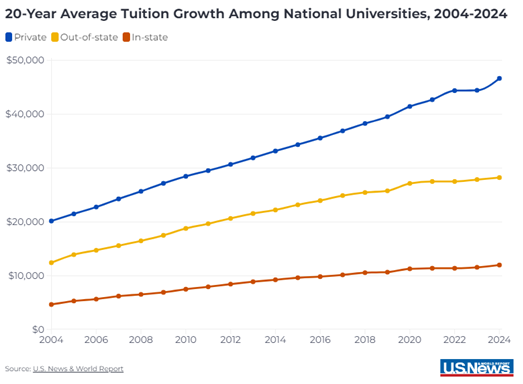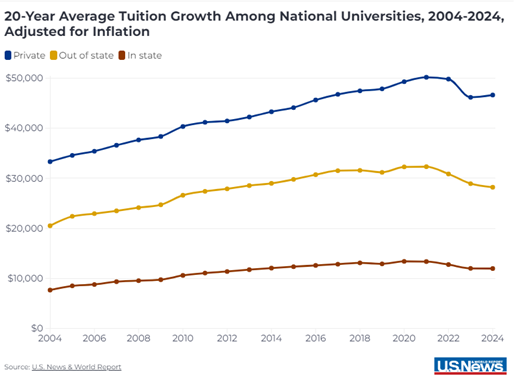As the end of high school approaches, many families find themselves grappling with the financial implications of post-secondary education. There are many options and paths available for today’s young adults. If discussions and planning with the young adults in your life have not yet begun, it is imperative to start these conversations with high school sophomores and juniors. Understanding the costs associated with college and exploring viable alternatives can help parents and grandparents support young adults in their lives to make informed decisions about their futures.
The Costs of College
According to the Education Data Initiative, “the average annual cost of tuition at a public 4-year college is 23 times higher than tuition in 1963,” and “after adjusting for currency inflation, college tuition has increased 747.8% since 1963.” It is imperative for parents and grandparents to understand this fact. The following graphs from US News and World Report allow you to visualize the average tuition growth, nationally, for the main three college enrollment types of private, out-of-state public, and in-state public universities. The second version of the graph is adjusted for inflation.
Tuition is only one part of the total costs associated with attending college. Non-tuition costs have also increased. These estimable costs can generally be categorized as follows:
- Tuition and Fees
- Public In-State Colleges: The national average annual tuition is about $10,500. For universities in Pennsylvania’s State System of Higher Education (PASSHE) the average annual tuition and fees for this upcoming year is closer to $11,000.
- Public Out-of-State Colleges: Average annual tuition is about $27,000.
- Private Colleges: Average annual tuition is about $37,500.
- For Pennsylvania families looking at this upcoming year, universities in Pennsylvania’s State System of Higher Education (PASSHE)* will have an average annual tuition and fee amount closer to $11,000, and universities in the Commonwealth System of Higher Education (CSHE)* will have an average annual tuition and fee amount closer to $20,000.
- Room and Board
- These costs typically range from $10,000 to $14,000 per year, depending on the institution and location.
- PASSHE on campus housing and food plans will be around $11,500.
- CSHE on campus housing and food plans will be around $15,000.
- Books and Supplies
- On average, students spend about $2,500 per year, but depending on a student’s course load and subject matter, this cost could be much greater.
- Additional Expenses
- Includes transportation, personal expenses, and other miscellaneous costs, often totally $5,000 annually.
- Total Annual Costs
- National Public In-State Average: $28,000-$32,000.
- National Public Out-of-State Average: $44,500-$50,000.
- National Private College Average: $60,000-$90,000.
These total costs have a wide range, all dependent on the many variables that go into each student’s individual college choices. It is important to gather and review as much information as possible. Many schools have these costs publicly documented with helpful tools for determining specific costs and financial aid opportunities. It is also very important to visit and see a school as part of the application process. Typically tours and open houses will be geared towards high school juniors and seniors, but it’s never too early to start.
Alternatives to Traditional College
Four-year college is not for everyone and there are many alternatives to this route that have their own set of costs and benefits.
- Community College
- Cost: The overall price point will be significantly lower, with average total annual costs around $10,000 for a full-time schedule.
- Benefits: Lower initial cost, flexibility with part-time options, ability to transfer credits to a four-year institution, ability to earn associate’s degrees and certifications, and the ability to earn additional credits while in high school or between sessions at a traditional institution.
- Trade Schools
- Cost: Typically ranges from $5,000 to $15,000 for the entire program, depending on the field of study.
- Fields: Welding, plumbing, electrical, cosmetology, and more.
- Benefits: Shorter duration (usually 1-2 years), high demand for skilled trades, and immediate entry into the workforce.
- Apprenticeships
- Cost: Often free, with participants earning a wage while they learn.
- Fields: Various trades and industries such as construction, healthcare, and information technology.
- Benefits: Earn while you learn, hands-on training, ready availability to industry resources, and industry-recognized credentials.
- Online Education
- Cost: Varies widely; some programs offer lower costs than traditional colleges.
- Benefits: Flexibility to study from anywhere, ability to work while studying, and a wide range of programs.
- Gap Year
- Cost: Can vary greatly depending on activities (volunteering, travel, internships).
- Benefits: Time to mature, gain work experience, and clarify career interests.
- Entrepreneurship
- Cost: Start-up costs and capital investments will depend on the kind of activity.
- Benefits: Ability to pursue financial and productive interests for “real-world” experience immediately.
Financial Aid and Scholarships
Adding up the costs to go to a 4-year college can be very sobering. Part of planning for this financial undertaking is taking advantage of the many resources that are available. Here are some of the general alternatives to consider:
- Federal Financial Aid
- This includes Pell Grants and Federal Student Loans
- All families should submit the Free Application for Federal Student Aid (FAFSA) to receive available financial aid underwritten for their specific financial capacities.
- State Aid
- State-specific grants and scholarships.
- This aid is also accessed by filling out and submitting the FAFSA information.
- Institutional Aid
- Scholarships and grants offered directly by colleges and universities.
- Institutions will have specific available funding to make sure that academically qualified students are able to attend their schools.
- Private Scholarships
- Offered by various organizations, businesses, and foundations.
- Requirements and qualifications for these scholarships vary and are typically accessed by submitting applications. A student can fund the majority of their education expenses just by taking the time to submit relevant essays.
- Savings Plans
- 529 Plans, which offer tax advantages for education savings.
- Information on these plans’ specific advantages and their mechanics is laid out in a previous newsletter, but these are great ways for both family members and future students to benefit from putting money aside as soon as possible.
Making an Informed Decision
A satisfying and successful decision can be reached with the help of the following:
- Assess Career Goals
- Encourage young adults in your life to explore their interests and career aspirations. Some professions may require a traditional four-year degree, while others may be attainable through alternative paths.
- Consider Financial Implications
- Evaluate the long-term financial impact of student loans and potential earnings in chosen careers. Utilize online calculators to estimate loan repayment and salary projections.
- Explore All Options
- Visit colleges, trade schools, and apprenticeship programs. Attend informational sessions and speak with current students and professionals in the field.
- Plan Early
- Start discussing post-secondary plans in the sophomore year of high school to allow ample time for research, applications to appropriate resources, and financial planning.
By weighing the costs and benefits of various educational paths, families can make strategic decisions that align with their financial situations and the student’s career goals. A young adult’s journey into the real world can and should be financially manageable. This article has been an introduction to the many considerations in this decision-making process. The financial planning team at Baldwin is excited to help our clients with these decisions along their life’s journey.
–//–
Sources and References:
*List of PASSHE Schools: Cheyney University; Commonwealth University – Bloomsburg, Lock Haven, and Mansfield campuses; East Stroudsburg University; Indiana University of Pennsylvania; Kutztown University; Millersville University; Pennsylvania Western University – California, Clarion, and Edinboro campuses; Shippensburg University; Slippery Rock University; and West Chester University.
**List of CSHE Schools: Lincoln University, the Pennsylvania State University, Temple University, and the University of Pittsburgh
https://www.passhe.edu/students/university-tuition-and-fee-rates.html
Benjamin Meck, CPA, Tax/Accounting Associate
Benjamin joined Baldwin Family Office in 2023 after spending 8 years gaining experience in corporate, cost, construction, and property accounting. He holds a B.S.B.A in both Accounting and Finance from Bloomsburg University of Pennsylvania. He earned the CPA designation in 2022. He is a member of the Pennsylvania Institute of Certified Public Accountants and the National Association of Tax Professionals.



